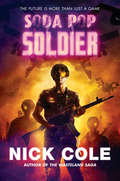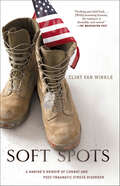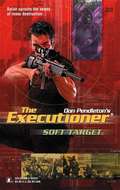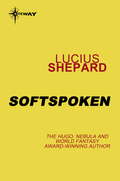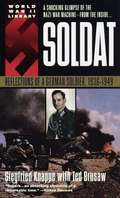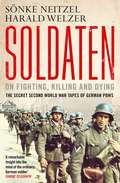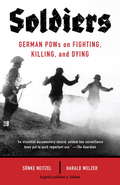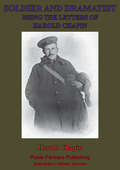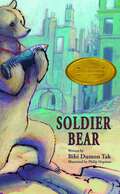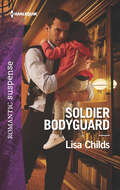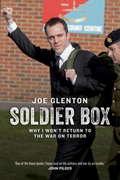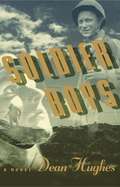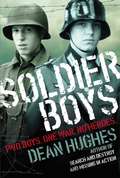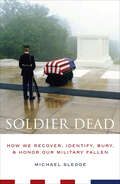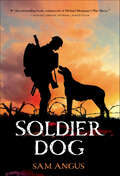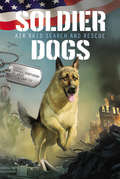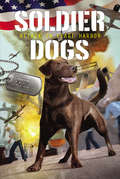- Table View
- List View
Soda Pop Soldier
by Nick ColeWhen the virtual world gets real . . .Gamer PerfectQuestion fights for ColaCorp in WarWorld, an online combat-sport arena where megacorporations field entire armies in the battle for dominance over real-world global-advertising space. Within the immense virtual battlefield, players and bots are high-tech grunts, using dropships and state-of-the-art assault rifles to attack the enemy.But when times are tough, there's always the Black, an illegal open-source tournament where the sick and twisted desires of the future are given free reign. And what begins as PerfectQuestion's onetime effort to make some cash quickly turns dangerous.All too soon, the real and virtual worlds collide when PerfectQuestion refuses to become the tool of a madman intent on hacking the global economy for himself and fights to stay alive--in WarWorld, in the Black, and in the real world.
Soft Spots: A Marine's Memoir of Combat and Post-Traumatic Stress Disorder
by Clint Van WinkleA powerful, haunting, provocative memoir of a Marine in Iraq—and his struggle with Post Traumatic Stress Disorder in a system trying to hide the damage done Marine Sergeant Clint Van Winkle flew to war on Valentine's Day 2003. His battalion was among the first wave of troops that crossed into Iraq, and his first combat experience was the battle of Nasiriyah, followed by patrols throughout the country, house to house searches, and operations in the dangerous Baghdad slums. But after two tours of duty, certain images would not leave his memory—a fragmented mental movie of shooting a little girl; of scavenging parts from a destroyed, blood-spattered tank; of obliterating several Iraqi men hidden behind an ancient wall; and of mistakenly stepping on a "soft spot," the remains of a Marine killed in combat. After his return home, Van Winkle sought help at a Veterans Administration facility, and so began a maddening journey through an indifferent system that promises to care for veterans, but in fact abandons many of them. From riveting scenes of combat violence, to the gallows humor of soldiers fighting a war that seems to make no sense, to moments of tenderness in a civilian life ravaged by flashbacks, rage, and doubt, Soft Spots reveals the mind of a soldier like no other recent memoir of the war that has consumed America.
Soft Target (Executioner #323)
by Don Pendleton Jerry Van CookNew intelligence in the form of confiscated terrorist-training films indicates a highly orchestrated chain of catastrophic violence is about to spread like wildfire across the United States. Assassinations of government officials, the mass murder of innocents at shopping malls and churches, and suicide bombings will simply lay the groundwork for the big event to come. Operating on razor-sharp instincts, Mack Bolan begins at the beginning- tracking targeted victims and taking out the enemy before havoc ensues, picking up bits of the puzzle and piecing together the grim picture. A mass hostage-taking at a large university demands every bit of steel the Executioner's got, but even the worst that unfolds is a cakewalk compared to a relentless enemy's next calculated act of devastation.
Softspoken
by Lucius ShepardA chilling and mysterious voice becomes audible to Sanie shortly after she and her husband Jackson move into the decaying antebellum mansion that is the Bullard ancestral home in rural South Carolina. At first, she wonders if the voice might be a prank played by Jackson's peyote-popping brother Will or his equally off-kilter sister Louise.But soon Sanie discovers that the ghostly voice is merely a single piece of the decadent, baroque puzzle that comprises the Bullard family history, rank with sensuality, violence, repression and madness.
Sold for Silver: An Autobiography (Biography And Memoir Ser.)
by Janet LimOriginally published in 1958, this is the true story of China-born Janet Lim, who was sold into slavery as a young girl in 1930’s Singapore.When Singapore falls to the Japanese in 1942, she escapes by ship, but when it is bombed and sinks, Janet floats at sea for days close to death. Rescued by fishermen, then captured by the Japanese, she narrowly escapes sexual-imprisonment as a comfort woman and is tortured.An inspirational autobiography of a true heroine.
Sold for Silver: An Autobiography (Biography And Memoir Ser.)
by Janet LimSold for Silver, first published in 1958, is the autobiographical account of Singaporean Chinese Janet Lim. The book covers her early childhood in China to the end of World War II. Janet Lim, an 'ordinary' person, lived in a time and had experiences that were anything but ordinary however: sold into domestic slavery as a child, living in Singapore when it was captured by the Japanese in 1942, aboard a ship that was bombed and sunk and then adrift in the ocean for a number of days, captured and held prisoner by the Japanese, selected to be a "comfort girl," and sentenced to be executed. Ms. Lim survived each challenge with her strong will, her faith, and with the help of close friends. Her book is a timeless true story of inspiration.
Soldaderas in the Mexican Military: Myth and History
by Elizabeth SalasThis study explores the evolving role of women soldiers in Mexico—as both fighters and cultural symbols—from the pre-Columbian era to the present.Since pre-Columbian times, soldiering has been a traditional life experience for innumerable women in Mexico. Yet the many names given these women warriors—heroines, camp followers, Amazons, coronelas, soldadas, soldaderas, and Adelitas—indicate their ambivalent position within Mexican society. In this original study, Elizabeth Salas challenges many traditional stereotypes, shedding new light on the significance of these women.Drawing on military archival data, anthropological studies, and oral history interviews, Salas first explores the real roles played by Mexican women in armed conflicts. She finds that most of the functions performed by women easily equate to those performed by revolutionaries and male soldiers in the quartermaster corps and regular ranks. She then turns her attention to the soldadera as a continuing symbol, examining the image of the soldadera in literature, corridos, art, music, and film.Salas finds that the fundamental realities of war link all Mexican women, regardless of time period, social class, or nom de guerre.
Soldados de Salamina (Colección Andanzas Ser. #Vol. 433)
by Javier CercasIn this bestselling literary novel Cercas takes the reader on an investigation of historic events to unravel an essential secret about Spain's most uncomfortable past, but most importantly, about the human condition. Rafael Sanchez Mazas, founder and ideologue of the Falange movement, manages to escape from a collective execution. As the Republicans look for him, an anonymous soldier points a gun at him, but lets him get away. He will hide out in the forest until the war ends, but he will always remember the soldier with the strange gaze that did not turn him in. Cercas tries to penetrate the mystery of the enigmatic Sanchez-Mazas, but only to discover that the true meaning of the story is found where least expected, « because one does not find what he looks for, but rather what life gives him.
Soldat: Reflections of a German Soldier
by Siegfried Knappe Ted BrusawThe Dell War Series takes you onto the battlefield, into the jungles and beneath the oceans with unforgettable stories that offer a new look at the terrors and triumphs of America's war experience. Many of these books are eyewitness accounts of the duty-bound fighting man. From the intrepid foot soldiers, sailors, pilots, and commanders, to the elite warriors of the Special Forces, here are stories of men who fight because their lives depend on it.
Soldaten
by Sönke Neitzel Harald WelzerA trove of previously unpublished, transcribed conversations among German POWs - secretly recorded by the Allies - reveals the extent of their brutality and changes our understanding of the mind-set of the German soldier during World War II. On a visit to the British National Archive in 2001, Sonke Neitzel made a remarkable discovery: reams of meticulously transcribed conversations among German POWs that had been covertly recorded and recently declassified. Neitzel would later find another collection of transcriptions, twice as extensive, in the National Archive in Washington, D. C. These were discoveries that would provide a unique and profoundly important window into the true mentality of the soldiers in the Wehrmacht, the Luftwaffe, the German navy, and the military in general--almost all of whom had insisted on their own honourable behaviour during the war. Collaborating with renowned social psychologist Harald Welzer, Neitzel examines these conversations--and the casual, pitiless brutality omnipresent in them--from a historical and psychological perspective, and in reconstructing the frameworks and situations behind these conversations, they have created a powerful narrative of wartime experience. 'these extraordinary bugged conversation reveal through the eyes of German soldiers with stark clarity and candour the often brutal reality of the Second World War, providing remarkable insight into the mentality and behaviour of the Wehrmacht. ' Sir Ian Kershaw'Nothing short of sensational . . . [Soldaten] has the potential to change our view of the war. ' Der Spiegel
Soldaten
by Jefferson Chase Harald Welzer Sonke NeitzelIn 2001, spurred by a nagging curiosity over a transcript of a secretly recorded conversation he had come across in his research on the German U-boat wars, historian Sönke Neitzel paid a visit to the British national archives. He had heard of the existence of recorded interrogations of German POWs, but never about covert recordings taken within the confines of the holding cells, bedrooms, and camps that housed the prisoners. What Neitzel discovered, to his amazement, were reams of untouched, recently declassified transcripts totaling nearly eight hundred pages. Later, Neitzel would find another trove of protocols twice as extensive at the National Archives in Washington, D.C. Though initially recorded by British intelligence with the intention of gaining information that might be useful for the Allied war effort, the matters discussed in these conversations ultimately proved to be limited in that regard. But for Neitzel and his collaborator, renowned social psychologist Harald Welzer, they would supply a unique and profoundly important window into the mentality of the soldiers in the Wehrmacht, the Luftwaffe, the German navy, and the military in general, almost all of whom had insisted on their own honorable behavior during the war. It is a myth these transcripts unequivocally debunk. Soldaten closely examines these conversations, and the casual, pitiless brutality omnipresent in them, from a historical and psychological perspective. What factors led to the degradation of the soldiers' sense of awareness and morality? How much did their social environments affect their interpretation of the war and their actions during combat? By reconstructing the frameworks and situations behind these conversations, and the context in which they were spoken, a powerful, unflinching narrative of wartime experience emerges. The details of what these soldiers did, after all, are not filtered the way they might be in letters to family, or girlfriends and wives, or during interrogations by the enemy. In Soldaten, Sönke Neitzel and Harald Welzer offer an unmitigated window into the mind-set of the German fighting man, potentially changing our view of World War II.
Soldier And Dramatist—Being The Letters Of Harold Chapin: American Citizen Who Died For England At Loos On September 26th, 1915
by Harold Chapin"Harold Chapin was a US born actor, author and playwright who volunteered for the British Army in 1914. He served with the 1st/6th Field Ambulance unit and was killed in the battle of Loos. The letters in this memorial volume give a rare insight into the work of a front-line ambulance unit early in the Great War."N&M Print Version
Soldier At Heart: From Private to General
by Michael ReynoldsGrowing up during the Second World War, Mike Reynolds became so interested in soldiering that he decided to make the Army his life. Joining as a National Serviceman, to see if he would really like being a soldier, he made the decision to become a professional and was commissioned into The Queens Royal Regiment. He saw action and was wounded severely in the Korean War but recovered and eventually rose to command an infantry battalion. In between, he had his first taste of Northern Ireland in 1969 and later returned as a Commanding Officer. He commanded 12 Mechanized Brigade in Germany and was later appointed to command the multi-national Allied Mobile Force (Land), during which time he was a target for a number of terrorist groups. On retiring from the Army, Mike Reynolds became a well-known military historian and author.
Soldier Athletes
by Glenn StoutStories of bravery and self-sacrifice from well known athletes who have served in the military. -Ted Williams, Boston Red Sox outfielder, whose career was interrupted by service as a pilot during both World War II and Korea, where he saw combat and survived a crash landing. -Rocky Bleier, Pittsburgh Steelers running back: Drafted in 1968, nearly lost a foot on a land mine during Vietnam War. -Carlos May, Chicago White Sox outfielder, an emerging star whose fought to remain in the major leagues after a training accident during National Guard service caused him to lose his thumb. -Pat Tillman, Arizona Cardinals defensive back who turned down a multi-million dollar contract to join the military after 9/11and was later killed in Afghanistan.
Soldier Bear
by Bibi Dumon TakWinner of the 2012 Batchelder AwardBased on a real series of events that happened during World War II, Soldier Bear tells the story of an orphaned bear cub adopted by a group of Polish soldiers in Iran. The soldiers raise the bear and eventually enlist him as a soldier to ensure that he stays with the company. He travels with them from Iran to Italy, and then on to Scotland. Voytek's mischief gets him into trouble along with way, but he also provides some unexpected encouragement for the soldiers amidst the reality of war: Voytek learns to carry bombs for the company, saves the camp from a spy, and keeps them constantly entertained with his antics.Always powerful and surprising, Bibi Dumon Tak's story offers readers a glimpse at this fascinating piece of history.
Soldier Bodyguard: The Colton Marine Her Lieutenant Protector Bodyguard Reunion The Soldier's Seduction (Bachelor Bodyguards #8)
by Lisa ChildsCole Bentler’s mission is to serve and protect…A Bachelor Bodyguards romanceFormer marine Cole Bentler’s new assignment: protect the recently widowed love of his life! Shawna Rolfe’s never been far from Cole’s thoughts, but now it’s up to him to ensure her safety—and guard her young daughter. A daughter whose eyes somehow look just like his… Once his secret daughter’s identity is exposed, can Cole forgive Shawna before the killer has them both trapped?
Soldier Box
by Joe Glenton"I looked around my cell and saw the sheet of paper taped to the door at chest height. It listed everything in the room, chair, bed, soldier box ... For a moment I thought it meant the cell itself; a box to put soldiers in."When the War on Terror began, Briton Joe Glenton felt compelled to serve his nation. He passed through basic training and deployed to Afghanistan in 2006. What he saw overseas left him disillusioned, and he returned home increasingly political and manifesting symptoms of post-traumatic stress disorder.When he refused to return for a second tour, he was denied his right to object and called "a coward and a malingerer." He went absent without leave and left the country, returning later to the UK voluntarily to campaign against the wars. The military accused him of desertion and threatened years in prison. Soldier Box tells the story of Glenton's extraordinary journey from a promising soldier to a rebel against what he came to see as unjustified military action.
Soldier Boys
by Dean HughesSpencer Morgan And Dieter Hedrick, one American, one German, are both young and eager to get into action in the war. Dieter, a shining member of the Hitler Youth movement, has actually met the Führerhimself and was praised for his hard work. Now he is determined to make it to the front lines, to push back the enemy and defend the honor of the Fatherland. Spencer, just sixteen, must convince his father to sign his induction papers. He is bent on becoming a paratrooper -- the toughest soldiers in the world. He will prove to his family and hometown friends that he is more than the little guy with crooked teeth. He'll prove to his father that he can amount to something and keep his promises. Everyone will look at him differently when he returns home in his uniform, trousers tucked into his boots in the paratrooper style. Both boys get their wishes when they are tossed into intense conflict during the Battle of the Bulge. And both soon learn that war is about a lot more than proving oneself and one's bravery. Dean Hughes offers young readers a wrenching look at parallel lives and how innocence must eventually be shed.
Soldier Boys
by Dean HughesSpencer Morgan And Dieter Hedrick, one American, one German, are both young and eager to get into action in the war. Dieter, a shining member of the Hitler Youth movement, has actually met the Führer himself and was praised for his hard work. Now he is determined to make it to the front lines, to push back the enemy and defend the honor of the Fatherland.Spencer, just sixteen, must convince his father to sign his induction papers. He is bent on becoming a paratrooper -- the toughest soldiers in the world. He will prove to his family and hometown friends that he is more than the little guy with crooked teeth. He?ll prove to his father that he can amount to something and keep his promises. Everyone will look at him differently when he returns home in his uniform, trousers tucked into his boots in the paratrooper style.Both boys get their wishes when they are tossed into intense conflict during the Battle of the Bulge. And both soon learn that war is about a lot more than proving oneself and one?s bravery. Dean Hughes offers young readers a wrenching look at parallel lives and how innocence must eventually be shed.
Soldier Dead: How We Recover, Identify, Bury, & Honor Our Military Fallen
by Michael SledgeThe first book to address the complicated issues surrounding what happens to members of the United States Armed Forces after they die. Why does recovering the remains of servicepeople matter? Soldier Dead examines this question and provides a thorough analysis of the processes of recovery, identification, return, burial, and remembrance of the dead. Sledge traces the ways in which the handling of our Soldier Dead has evolved over time and how these changes have reflected not only advances in technology and capabilities but also the shifting attitudes of the public, government, and military. He also considers the emotional stress experienced by those who handle the dead; the continuing efforts to retrieve bodies from Korea and elsewhere; and how unresolved issues regarding the treatment of enemy dead continue to affect U.S. foreign relations. Skillfully incorporating excerpts from interviews, personal correspondence and diaries, military records, and journalistic accounts—as well as never-before-published photographs and his own reflections—Michael Sledge presents a clear, concise, and compassionate story about what the dead mean to the living. Throughout Soldier Dead, the voices of the fallen are heard, as are those of family members and military personnel responsible for the dead before final disposition. At times disturbing and at other times encouraging, they are always powerful as they speak of danger, duty, courage, commitment, and care. &“A timely and detailed investigation into the moral conscience of American society which will be of interest to anyone concerned with the human costs of war. An important and passionate book which deserves a wide readership.&”—Chris Shilling, University of Portsmouth, UK
Soldier Dead: How We Recover, Identify, Bury, and Honor Our Military Fallen (Published By The Middle East Institute)
by Michael SledgeWhat happens to members of the United States Armed Forces after they die? Why do soldiers endanger their lives to recover the remains of their comrades? Why does the military spend enormous resources and risk further fatalities to recover the bodies of the fallen, even decades after the cessation of hostilities? Soldier Dead is the first book to fully address the complicated physical, social, religious, economic, and political issues concerning the remains of men and women who die while serving their country. In doing so, Michael Sledge reveals the meanings of the war dead for families, soldiers, and the nation as a whole.Why does recovering the remains of servicepeople matter? Soldier Dead examines this question and provides a thorough analysis of the processes of recovery, identification, return, burial, and remembrance of the dead. Sledge traces the ways in which the handling of our Soldier Dead has evolved over time and how these changes have reflected not only advances in technology and capabilities but also the shifting attitudes of the public, government, and military. He also considers the emotional stress experienced by those who handle the dead; the continuing efforts to retrieve bodies from Korea and elsewhere; and how unresolved issues regarding the treatment of enemy dead continue to affect U.S. foreign relations. Skillfully incorporating excerpts from interviews, personal correspondence and diaries, military records, and journalistic accounts-as well as never-before-published photographs and his own reflections-Michael Sledge presents a clear, concise, and compassionate story about what the dead mean to the living. Throughout Soldier Dead, the voices of the fallen are heard, as are those of family members and military personnel responsible for the dead before final disposition. At times disturbing and at other times encouraging, they are always powerful as they speak of danger, duty, courage, commitment, and care.
Soldier Dog
by Sam AngusWith his older brother gone to fight in the Great War, and his father prone to sudden rages, 14-year-old Stanley devotes himself to taking care of the family's greyhound and puppies. Until the morning Stanley wakes to find the puppies gone.<P><P> Determined to find his brother, Stanley runs away to join an increasingly desperate army. Assigned to the experimental War Dog School, Stanley is given a problematic Great Dane named Bones to train. Against all odds, the pair excels, and Stanley is sent to France.<P> But in Soldier Dog by Sam Angus, the war in France is larger and more brutal than Stanley ever imagined. How can one young boy survive World War I and find his brother with only a dog to help?
Soldier Dog
by Sam AngusWith his older brother gone to fight in the Great War, and his father prone to sudden rages, 14-year-old Stanley devotes himself to taking care of the family's greyhound and puppies. Until the morning Stanley wakes to find the puppies gone.Determined to find his brother, Stanley runs away to join an increasingly desperate army. Assigned to the experimental War Dog School, Stanley is given a problematic Great Dane named Bones to train. Against all odds, the pair excels, and Stanley is sent to France. But in Soldier Dog by Sam Angus, the war in France is larger and more brutal than Stanley ever imagined. How can one young boy survive World War I and find his brother with only a dog to help?
Soldier Dogs #1: Air Raid Search and Rescue (Soldier Dogs #1)
by Marcus Sutter Pat KinsellaThe paw-biting start to a thrilling new adventure series perfect for fans of Max and the I Survived books, inspired by the brave military dogs who helped our troops win World War II.When Matt’s older brother enlisted in the army, he left Matt his German Shepherd, Chief, a retired fire dog and the best pet EVER. So Matt isn’t happy when Chief starts paying attention to his foster sister Rachel instead of him.But when Nazi planes begin bombing the city, Matt finds himself in an impossible situation. Can he be a hero to his sister when it matters most? And when they get caught outside during the air raid, will Chief be there to save the day?
Soldier Dogs #2: Attack on Pearl Harbor (Soldier Dogs #2)
by Marcus Sutter Andie Tong LumInspired by the stories of the real dogs who courageously served during World War II, this action-packed book takes readers into the action during the Japanese attack on Pearl Harbor.When Skipper, the street dog all the Navy guys love, follows Joe home, Joe can’t believe his luck. But with a new baby brother in the house, he knows his family can’t afford the extra mouth to feed.So he and his friends hatch a perfect plan: present Skipper to Joe’s dad, who works on the USS West Virginia, as a mascot dog for the ship. But when Joe is interrupted by the Japanese surprise attack on the harbor, it may be up to Skipper to make sure they all make it out alive.Perfect for fans of the bestselling Max and Hero books!
